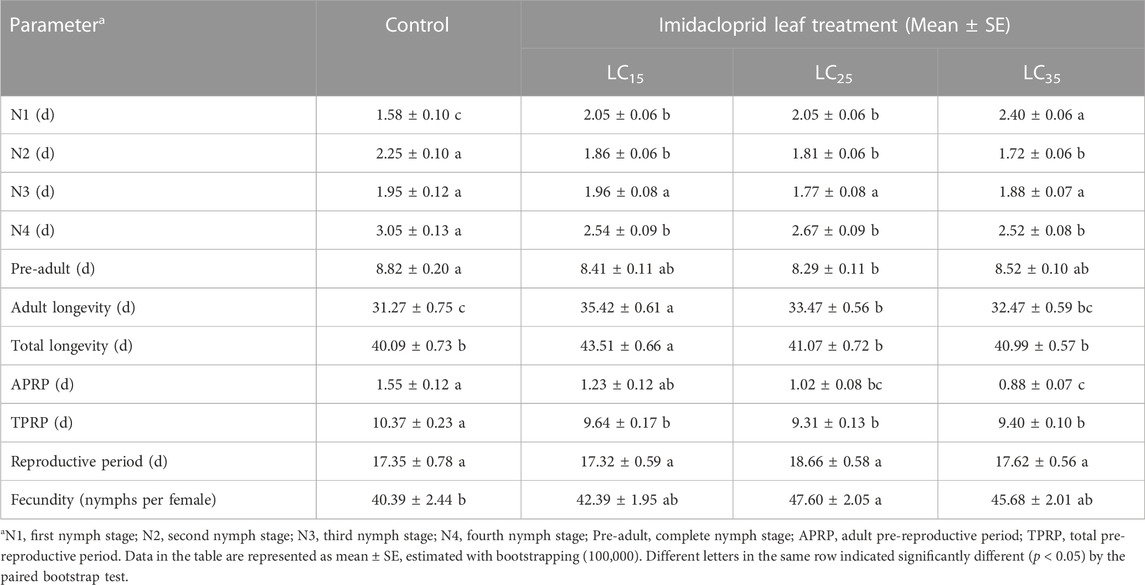
95% of researchers rate our articles as excellent or good
Learn more about the work of our research integrity team to safeguard the quality of each article we publish.
Find out more
CORRECTION article
Front. Physiol. , 06 June 2023
Sec. Invertebrate Physiology
Volume 14 - 2023 | https://doi.org/10.3389/fphys.2023.1186884
This article is part of the Research Topic The Side Effects of Insecticides on Insects and the Adaptation Mechanisms of Insects to Insecticides View all 15 articles
This article is a correction to:
Effects of imidacloprid-induced hormesis on the development and reproduction of the rose-grain aphid Metopolophium dirhodum (Hemiptera: Aphididae)
A Corrigendum on
Effects of imidacloprid-induced hormesis on the development and reproduction of the rose-grain aphid Metopolophium dirhodum (Hemiptera: Aphididae)
by Li X, Li Y, Zhu X, Li X, Cheng D and Zhang Y (2023). Front. Physiol. 14:1113464. doi: 10.3389/fphys.2023.1113464
In the published article, there was an error in the note for Table 1 as published. The word “paired” was missing from the following sentence: “Different letters in the same row indicated significantly different (p < 0.05) by the bootstrap test.” The corrected table note appears below.

TABLE 1. The sub-lethal effects of imidacloprid on developmental duration and fecundity of the F1 generation of Metopolophium dirhodum.
In the published article, there was an error in the note for Table 2 as published. The word “paired” was missing from the following sentence: “Different letters in the same row indicated significantly different (p < 0.05) by the bootstrap test.” The corrected table note appears below.

TABLE 2. Sub-lethal effects of imidacloprid on population parameters of the F1 generation of Metopolophium dirhodum.
In the published article, there was an error in Table 2 as published. Some of the data in Table 2 should be kept 4 digits behind the decimal point. The corrected Table 2 and its caption appear below.
In the published article, there was an error. Some corrections have been made to Results, Transgenerational sub-lethal effects of the imidacloprid on survival rates, life expectancy and reproductive value of the M. dirhodum F1 generation, paragraph two. This sentence previously stated:
“The age-stage specific life expectancy (exj) refers to the predicted survival of an individual at age x and stage j at a later age x. Compared with control, the F1 individuals produced by F0 imidacloprid-treated had a higher life expectancy (Figure 4). Moreover, newborn M. dirhodum nymphs were expected to live for 56, 62, and 52 days following the 50, 100, and 200 mg/L imidacloprid treatments, respectively, for only 49 days in response to the control treatment (Figure 4).”
In the corrected sentence, “survival” was changed to “survival time” due to a missing word, “at a later age x” was deleted as these were superfluous words, and “F0” was corrected to “F0” since “0” should be subscripted. Additionally, “56, 62, and 52 days” was changed to “57, 63, and 53 days” and “49 days” was changed to “50 days”. The first day that the life expectancy value in Figure 4 is 0 should be added, so the life expectancy value for each treatment should be added by 1 day.
The corrected sentence appears below:
“The age-stage specific life expectancy (exj) refers to the predicted survival time of an individual at age x and stage j. Compared with control, the F1 individuals produced by F0 imidacloprid-treated had a higher life expectancy (Figure 4). Moreover, newborn M. dirhodum nymphs were expected to live for 57, 63, and 53 days following the 50, 100, and 200 mg/L imidacloprid treatments, respectively, for only 50 days in response to the control treatment (Figure 4).”
The authors apologize for these errors and state that this does not change the scientific conclusions of the article in any way. The original article has been updated.
All claims expressed in this article are solely those of the authors and do not necessarily represent those of their affiliated organizations, or those of the publisher, the editors and the reviewers. Any product that may be evaluated in this article, or claim that may be made by its manufacturer, is not guaranteed or endorsed by the publisher.
Keywords: hormesis, imidacloprid, Metopolophium dirhodum, longevity, fecundity
Citation: Li X, Li Y, Zhu X, Li X, Cheng D and Zhang Y (2023) Corrigendum: Effects of imidacloprid-induced hormesis on the development and reproduction of the rose-grain aphid Metopolophium dirhodum (Hemiptera: aphididae). Front. Physiol. 14:1186884. doi: 10.3389/fphys.2023.1186884
Received: 15 March 2023; Accepted: 22 May 2023;
Published: 06 June 2023.
Edited by:
Ting Li, Alabama State University, United StatesReviewed by:
Jianhong Li, Huazhong Agricultural University, ChinaCopyright © 2023 Li, Li, Zhu, Li, Cheng and Zhang. This is an open-access article distributed under the terms of the Creative Commons Attribution License (CC BY). The use, distribution or reproduction in other forums is permitted, provided the original author(s) and the copyright owner(s) are credited and that the original publication in this journal is cited, in accordance with accepted academic practice. No use, distribution or reproduction is permitted which does not comply with these terms.
*Correspondence: Yunhui Zhang, eWh6aGFuZ0BpcHBjYWFzLmNu
†These authors have contributed equally to this work
Disclaimer: All claims expressed in this article are solely those of the authors and do not necessarily represent those of their affiliated organizations, or those of the publisher, the editors and the reviewers. Any product that may be evaluated in this article or claim that may be made by its manufacturer is not guaranteed or endorsed by the publisher.
Research integrity at Frontiers

Learn more about the work of our research integrity team to safeguard the quality of each article we publish.